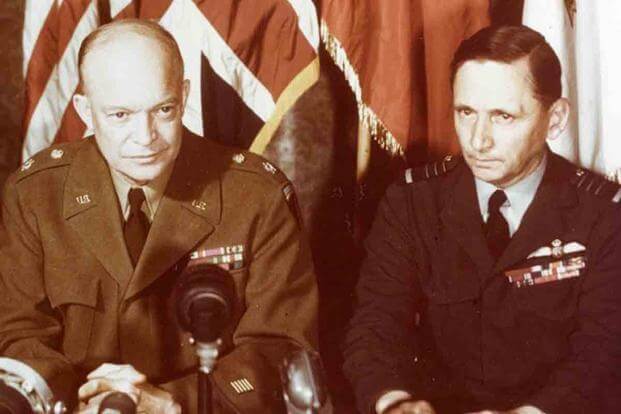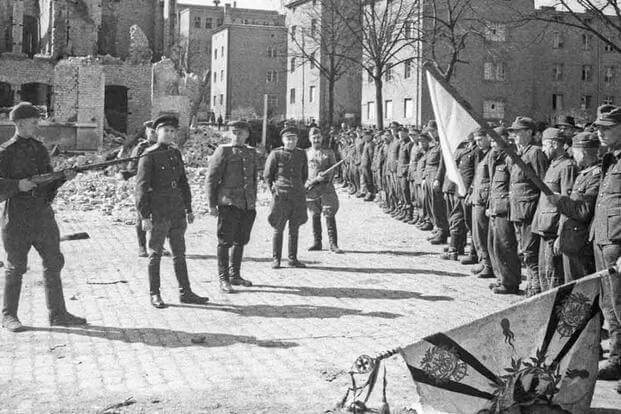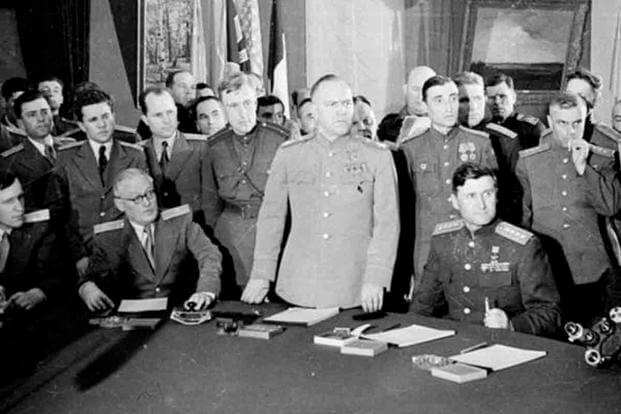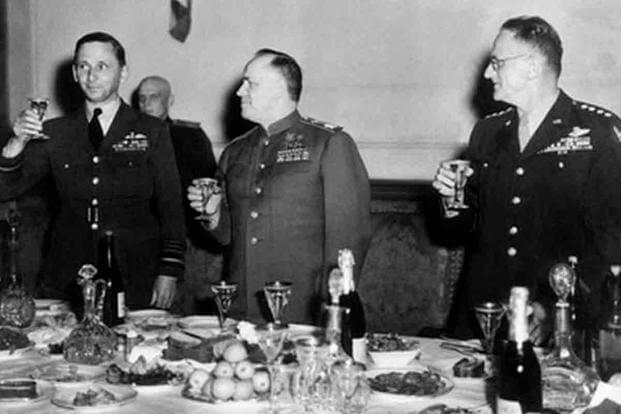One good turn, the saying goes, deserves another. The Allied forces of World War II were more than ready to accept a Nazi surrender, but when they realized they might have left a potential loophole for Germany to continue fighting the Soviet Union, however, they had no qualms about forcing their vanquished foe to sign another, more complete surrender.
Adolf Hitler’s suicide in his Berlin bunker on April 30, 1945, didn’t immediately end World War II in Europe. Though the German capital had fallen to the Soviets, pockets of Nazi troops would continue fighting for more than a week in France, Germany, the Mediterranean and elsewhere. And when the Nazis finally did accede to the Allies’ demand for unconditional surrender, once-proud German generals had to put their tails between their legs and sign an instrument of that surrender not once, but twice.
Though equally brief, the two surrenders were markedly different in both mood and tenor. The chief difference between them was the Soviets. The fighting on World War II’s Eastern Front was some of the most brutal warfare in the history of mankind, and it showed right up until the staunchly anti-communist Nazi regime was forced to surrender to the Red Army. While Germany’s surrender to the Western Allies was somber but cordial, the next day’s surrender in Berlin was tense, blunt and filled with suppressed anger.
The first surrender came in the early morning hours of May 7, 1945, at Gen. Dwight D. Eisenhower's headquarters in Reims, France. By then, German Adm. Karl Dönitz had succeeded HItler as head of state, and he sent Gen. Alfred Jodl to sign the surrender.
Along with Jodl, Germany was represented by Maj. Wilhelm Oxenius and Gen. Adm. Hans-Georg von Friedeburg. Lt. Gen. Walter Bedell Smith, Eisenhower’s chief of staff at Supreme Headquarters, Allied Expeditionary Force (SHAEF), received the Germans as the representative for the American and British forces. Gen. Ivan Susloparov represented the Soviet Union while French Maj. Gen. François Sevez signed as a witness.
The 30-by-30-foot room in a red-brick schoolhouse was filled with flood lights and some 60 people, including delegates and journalists. The crowd was reportedly nervous waiting for the Germans to arrive in the map-filled room, which they did at 2:39 a.m. Jodl clicked his heels and the three Nazis sat down. Two minutes later, the documents were signed.
“Only the atmosphere of cold military punctiliousness across the conference table was there to remind one of the Compiegne railroad car where the World War I armistice was signed,” United Press International war correspondent Boyd Lewis wrote at the time.
The whole thing was over in five minutes, according to one Stars and Stripes reporter. Jodl signed with just his last name and expressed his hope that the Allies would be generous to the German people.
"General, with this signature the German people and the German armed forces are for the better or worse delivered into the victor's hands,” Jodl told the Allied delegation. “In this war which has lasted more than five years both have achieved more and suffered more perhaps than any other people in the world.
“I express the hope the victor will treat them with generosity," he continued, his voice cracking slightly.
Ten minutes later, Jodl met with Eisenhower himself. Ike only asked whether Jodl understood the surrender details, to which he replied that he did, clicked his heels in salute and walked out, tripping on a cable along the way.

That might have been the end of the war -- except it wasn’t. Fighting between German and Soviet forces in Czechoslovakia and elsewhere continued for at least another full day. Moreover, the Act of Military Surrender ensured the submission of Germany’s armed forces, but not its government.
Dönitz was determined to continue the German government, unrepentant of Nazism, with the presidential powers Hitler left to him in accordance with the Weimar Constitution. Eisenhower wanted to ensure the German government surrendered while the Soviet Union was concerned the continued fighting on the Eastern Front made it look like the West had brokered a separate peace.
In reality, German troops had signed separate agreements piecemeal since the end of April. In Italy, German and Fascist Italian forces signed their surrender on April 29. Field Marshal Bernard Montgomery accepted the surrender of German forces in the Netherlands and northern Germany on May 4. The next day, fighting stopped in southern Germany when the Nazis surrendered to the Americans.
The Soviets, it turns out, had every reason to suspect the Germans were up to something. German forces in the east were fighting their way west in order to avoid surrendering to the Red Army while requesting permission to continue fighting. Writing in “The End: The Defiance and Destruction of Hitler's Germany,” renowned historian Ian Kershaw observed that both Dönitz and Field Marshal Wilhelm Keitel wanted to use what remained of the Wehrmacht to “rescue as many Germans as possible from Bolshevization and slavery.”

Friedeburg repeatedly made requests to Eisenhower for a partial capitulation, only to the western Allies, but Eisenhower refused anything that didn’t include the Soviet Union. Dönitz, who had formed a new German government in Flensburg, maintained the hope that the Allies would allow him to maintain his makeshift government as German troops flowed westward.
It took just six hours for the USSR to object to the Reims surrender. Moscow complained that the text of that instrument was different from what the Allies had previously agreed upon and that Susloparov didn’t have the authority to sign for the Soviet Union. Soviet leader Joseph Stalin, Kershaw wrote, wanted a tacit acknowledgment that the Red Army had borne the brunt of the fighting and dying by signing a surrender document in the German capital with the highest representatives of the German military command present. Eisenhower agreed.

It was under these circumstances that Keitel, then the overall commander of the German Army; Col. Gen. Hans-Jürgen Stumpff, commander of the Luftwaffe; and Adm. Friedeburg, commander of the German Navy, entered the former mess hall of Germany’s military engineering school in Karlshorst on May 8, 1945. At the time, the building was the headquarters for Soviet Marshal Georgy Zhukov.
In his book, “The Fall of Berlin 1945,” historian Antony Beevor wrote that the three German leaders entered the press-filled room looking “resigned” and “imperious.” Keitel raised his marshal’s baton in salute to Zhukov, British Air Marshal Arthur W. Tedder, French Gen. Jean de Lattre de Tassigny and American Gen. Carl Spaatz -- who did not respond. Keitel "sat very straight in his chair, with clenched fists. Just behind him, a tall German staff officer standing to attention … crying without a single muscle of his face moving."
Zhukov invited the Germans to come sign the documents, but Keitel gestured for them to be brought to him. Zhukov then told the interpreters, "Tell them to come here to sign." Keitel "ostentatiously" removed his gloves before signing. Clifford Webb of the now-defunct Daily Herald remarked that the Soviet press was difficult to control.
“They surged forwards until they all but engulfed the top table, pushing and struggling amongst themselves to thrust their cameras within inches of Keitel's furious face while he signed. Reporters stood on chairs until other reporters pushed them off," Webb said.
Kershaw wrote that Keitel’s hand shook as he signed the surrender. When five copies were signed, Zhukov dismissed the German delegation. Keitel again raised his baton, turned on his heels and the Germans left the room.
“As the door closed behind them, it was almost as if everybody in the room exhaled in unison,” Beevor wrote. “The tension relaxed instantaneously. Zhukov was smiling, so was [British Air Chief Marshal Sir Arthur] Tedder. Everybody began to talk animatedly and shake hands. Soviet officers embraced each other with bear hugs."
Now that the Soviet Union was satisfied and Nazi Germany was officially history, the post-surrender afterparty raged until dawn. Even Keitel and the Germans stuck around for a celebratory meal and drink, according to Kershaw. But the fallout from the surrender was just beginning.

Jodl would be charged with war crimes and sentenced to death. He was hanged at Nuremberg Prison on Oct. 16, 1946. His staff officer at Reims, Maj. Wilhelm Oxenius, was held as a prisoner of war until 1948. Dönitz’s dreams of forming a new German government were dashed when they were all arrested by British forces at Flensburg. Upon learning he would be tried as a war criminal, Hans-Georg von Friedeburg died by suicide. Dönitz would spend 10 years in West Berlin’s Spandau Prison.
Things were far worse for German soldiers. Some 30% of Germany’s 10 million troops were captured by the Red Army, Kershaw wrote, with at least one million dying in Soviet captivity.
The lasting legacy of these two surrender documents can be seen in the former allies’ commemoration of their victory in Europe. The Reims surrender was signed on May 7, 1945, but the news broke back home the next day, leading the Western Allies to celebrate V-E Day on May 8. Since the Soviet Union didn’t recognize the Reims agreement and the Nazi surrender in Berlin was signed on May 9, that’s the day Russia celebrates its Victory Day.
Want to Learn More About Military Life?
Whether you're thinking of joining the military, looking for post-military careers or keeping up with military life and benefits, Military.com has you covered. Subscribe to Military.com to have military news, updates and resources delivered directly to your inbox.
















